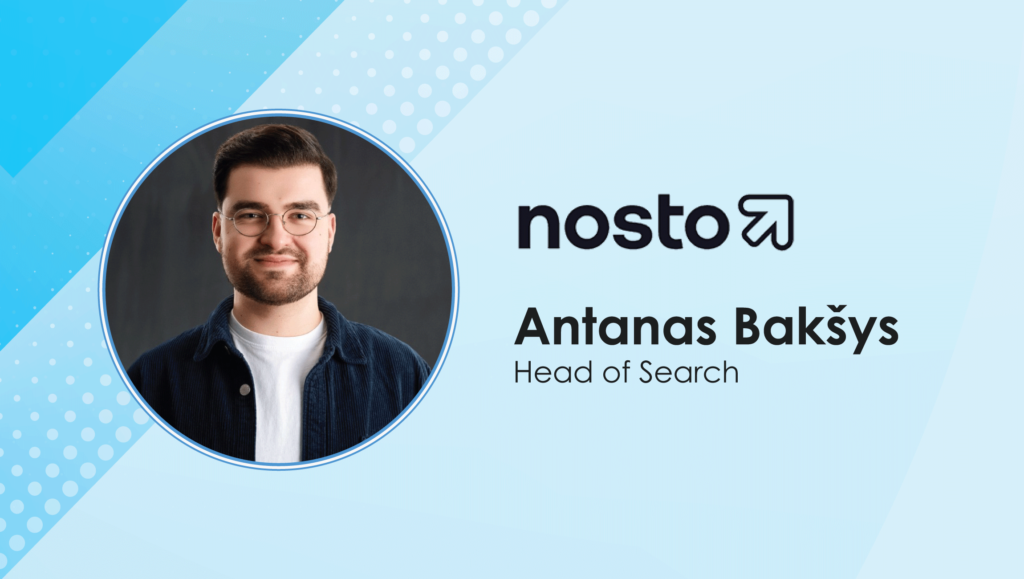Antanas Bakšys, Head of Search at Nosto highlights how key brands benefit from better digital and onsite product search experiences while taking us through a few common fails online retailers and eCommerce brands still struggle with today when trying to meet end user needs:
___________
Welcome to this SalesTechStar chat Antanas, tell us about yourself and more about your role at Nosto…
My previous career experience includes owning and running an ecommerce store and that’s what initially sparked my interest in on-site search. We had a frustrating experience with the search functionality that was available at the time. In many cases, people were unable to find the products they were looking for through search, even though we were selling them. And the experience could be slow and cumbersome.
That opened my eyes to the need for an improved ecommerce site search solution. So I founded SearchNode in 2013, with the goal of bringing more sophisticated cloud-based search technology to market. We had all the latest innovations that were around at the time such as auto-complete and spell check.
More recently, SearchNode has joined forces with Nosto and my role as Head of Search is all about trying to keep our search offering ahead of the game. Search is evolving and ecommerce brands now expect search to be more automated with self-learning functionality. For example, rather than just matching keywords to what shoppers enter into the search box, we try to understand the real meaning or intent behind them—with self-learning algorithms to help improve relevance.
We’d love for you to highlight the importance of a better on-site search function to reduce lost revenue opps for retailers/ecommerce businesses?
It’s quite simple. Poor site search has the power to drive your customers away. We commissioned consumer research at the start of this year which found that 69% of people go straight to the search bar when they visit online retail sites. But, scarily, 80% admitted leaving a site when the search experience wasn’t up to scratch.
And, on the flipside, retailers know only too well that poor search directly impacts sales. A parallel survey we ran among ecommerce merchants revealed that on average they assign around 39% of all traffic bouncing (visitors exiting straight away) to a poor search experience—or because people couldn’t find relevant products.
At the same time, customer expectations are rising, meaning ecommerce brands need to work even harder to ensure their search is delivering. The superior search experiences people get from the likes of Google and Amazon means they demand the same from every other site.
And increasing living costs make search even more important to today’s shopping journeys: 68% of consumers say rising prices mean they want to compare products from different online stores, and good ecommerce search makes this easier. Increasing competition and economic uncertainty underline why, if you’re an ecommerce merchant, you simply can’t afford to let poor search lead to lost revenue.
What are some of the common search failings you’ve seen several ecommerce sites sport?
One of the most important things for shoppers is getting search results that are actually relevant. But this is a problem that still hasn’t been cracked. For example, in our survey, 69% of shoppers said they often see irrelevant results when using ecommerce site search. And in our real-world site testing, we found 81% of ecommerce brand websites threw up irrelevant results for relatively basic search queries (of two words).
Achieving relevance is tricky, both because of the volume of data and the complexity of queries that retail sites have to handle. These days, people aren’t just entering one-word search queries, but being much more specific. For example, a shopper might search for “red running shorts with pockets”, rather than simply using the term “shorts”. Very often, they’ll be disappointed because they’ll see generic search results that don’t show them what they want.
Another failing is unnecessary friction in the search experience which only serves to irritate and frustrate customers more. For instance, one of the biggest bug-bears for many people is seeing products listed in search results only to find they’re out of stock or not available in the sizes they want. Another example is the inability to add filters to narrow down search results so that shoppers can find exactly what they’re looking for and quickly—without having to wade through pages of products. A related gripe is when search can’t handle synonyms—such as ‘couch’ for ‘sofa’, or ‘jogging pants’ for ‘track pants’.
Read More: SalesTechStar Interview with Joanna Johnston, Chief Customer Officer at BigPanda
Can you highlight more on some leading brands globally that have a great site search experience and how it enhances the purchase journey and eventual revenue in turn?
One good example is furniture and homewares retailer, Ikea, especially the way they ensure that the product thumbnails they display in search results always match what the visitor is searching for. For example, if I’m searching for “blue armchair”, the thumbnails that Ikea displays in search listings will only show images of armchairs that are blue and no other color variants will appear. This may sound a bit obvious, but many other brands don’t do it. In fact, research suggests 54% of online shops display static thumbnails that don’t match the shopper’s search query – which is confusing for shoppers and often leads to site abandonments.
As well as this, fashion brand, Perry Ellis, provides a great example of how it’s possible to personalize the site search experience using segmentation based on customer behavior. Perry Ellis uses Nosto’s tech to segment customers based on “style” affinities, such as whether they prefer casual shirts to dress shirts, for example. And they have set up rules for those segments about specific queries so those preferences are prioritized in search results. So, if a shopper is searching for linen clothes and has a clear affinity for a certain style (say dress wear rather than casual wear) the site will show linen dress wear in their results right away, without the shopper needing to manually sort them.
Also, fashion giant, Shein, does a good job of handling long tail search queries in which shoppers enter very detailed descriptions to find precisely what they want, such as “white mini skirt for petite with a belt”. We’re noticing that the average length of the queries in ecommerce search has significantly increased in recent years. In fact, today, long-tail searches like this represent 70% of queries so this is clearly an opportunity for retailers to tap into more revenue through search. But to achieve this their search solution needs to be able to understand the query using AI and natural language processing–it’s not just something you can do by simple keyword matching.
5What are the five fundamentals of a good site search capability set that leads to a seamless, frictionless buying journey?
First and foremost, relevance is key. Good site search has to be able to show shoppers what they are looking for, otherwise what’s the point? Ideally it needs to be able to understand the intent behind people’s search queries and increasingly that means incorporating AI and natural language processing technology to make results more relevant. These technologies automatically learn from customer behavior, helping to take the burden off ecommerce teams who no longer have to make manual interventions to improve search.
Secondly, speed is a foundational element of a good search experience. People don’t want to be waiting for slow loading search pages, so you must be able to deliver results in a timely manner. Fail to do this and your visitors will go elsewhere.
Next, you need to make the search experience really easy. This includes ensuring your search solution lets people set appropriate filters to narrow down search results so they can find what they want quickly. For example, if they are searching for jeans, they should be able to narrow the results down by the type of fit, whether that’s skinny, straight or boot cut. Similarly, features such as auto-complete and error tolerance—the ability to account for spelling mistakes or similar words within a query—can take the hassle out of using search.
On top of that, people today want to see results that are personalized. So, if they have a particular fitness brand that they usually prefer, then when they search for track pants or running shoes they want to see that brand prioritized in the results. Similarly, if they have been searching for size “small” clothes, they don’t want search results to show them clothes that are only available in XL sizes.
Number five: it’s now increasingly important to show shoppers relevant content as well as products in search results. For example, 59% of shoppers say they are likely to make purchases after consuming content such as articles, FAQs, and collection pages related to their search queries. The problem is that most ecommerce brands don’t currently surface this content in search results.
Underlining all of the above it’s important to remember that the job’s never finished when it comes to improving site-search. You need to be continually monitoring your search metrics and finding ways to improve. But most ecommerce brands are currently not tracking even key metrics like queries that deliver the highest revenue or those that deliver zero results. Acting on these insights can help you improve search performance and conversions.
Read More: Generative AI: Revolutionizing Marketing and Sales
Can you highlight more about the future of the B2B tech market and in what ways you expect to see it grow?
You won’t be surprised to hear that I think one of the biggest growth areas in B2B technology is generative AI and large language models. This is going to play a huge role in the future of digital marketing and online shopping journeys—and it very much includes the way ecommerce search is going to evolve.
AI has always been part of what we do and now our product team is in the process of rolling out even more aspects of AI functionality into the Nosto Commerce Experience Platform. You can expect to see features such as AI-assisted image labeling/tagging to automatically identify and organize visual content and dynamic AI-generated copy for any text fields in campaigns and widgets. We’re also going to introduce search relevancy enhanced by AI using ChatGPT’s large language model. So watch this space!
Nosto enables online brands to deliver authentic, relevant, and personalized experiences at every touchpoint, across every device. An AI-Powered Commerce Experience Platform (CXP) designed for ease of use, Nosto empowers brands to build, launch, and optimize compelling digital experiences without the need for dedicated IT resources or a lengthy implementation process. Leading brands in over 100 countries use Nosto to grow their business and delight their customers. Nosto supports its clients from its offices in New York, Los Angeles, London, Paris, Berlin, Stockholm, Sydney, Kaunas and Helsinki.
Antanas Bakšys is an international expert in ecommerce technologies. He was previously the CEO & Co-Founder of ecommerce search technology company, SearchNode, which was acquired by Nosto in 2022. Over a nine-year period, Antanas led SearchNode to become one of the top search and merchandising SaaS providers used by ecommerce retailers in North America and Europe.
Missed The Latest Episode of The SalesStar Podcast? Have a quick listen here!
Episode 175: Go-to Market and Marketing Best Practices with Bryan Law, CMO at Zoominfo
Episode 174: B2B Customer Engagement with Mike Molinet, Co-Founder, Thena
Episode 173: B2B Revenue Generation Hacks with Justin Schweisberger, Chief Revenue Officer at Pramata
















